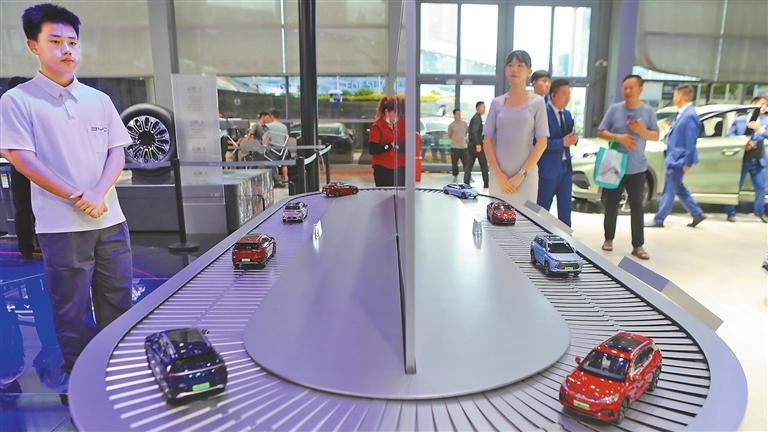
NEV models are on display at the BYD booth during the Guangdong-Hong Kong-Macao Greater Bay Area International Auto Show at the Shenzhen Convention & Exhibition Center in Futian District in June. Sun Yuchen
Hurun China New Energy Cities 2023 unveiled by Hurun Research Insititute in June, Shenzhen retained its title as China’s top city in terms of new energy industry concentration level, followed by Shanghai.
“Shenzhen has BYD and Shanghai has Tesla. NEVs are driving the whole industry supply chain, so the contribution of enterprises like Tesla and BYD to each city is far more than just car production,” Rupert Hoogewerf, chairman of Hurun, said.
Shenzhen is now home to 24,000 new energy and digital energy companies and over 20 listed companies in the charging pile sector.
Led by Shenzhen’s homegrown market leader BYD, these companies have achieved national leadership in core NEV technologies.
NEV leader BYD
BYD, which started by making batteries, has grown to become the world’s hottest maker of electric vehicles. It started making cars in 2003 and in 2022 it dropped its lineup of gas-powered vehicles to focus only on battery electric cars and plug-in hybrids.
The world’s first fully vertically integrated electric vehicle maker overtook Tesla to become the world’s top selling NEV maker with 1.87 million deliveries in 2022, compared with 1.3 million for Tesla.
The firm is now embarking on a rapid global expansion push and has made inroads into overseas markets starting with Norway in 2021, and now including Australia, Britain, Brazil, Costa Rica, Germany, Japan, Mexico and Singapore.
Supercharging stations
Shenzhen’s high penetration of NEVs has spawned the rapid development of charging infrastructure.
The city has promised to install 833,000 electric vehicle chargers by 2025. The latest official figures show that Shenzhen had 190,000 charging piles as of the end of June, becoming one of the Chinese cities with the largest electric vehicle charging network.
“With more chargers, there’s less range anxiety. More drivers are willing to switch to NEVs,” said Zhu Guichuan, a BYD car owner. “However, we still need to remember that charging takes much longer than refilling a gas tank. That’s a significant barrier to the acceleration of electric vehicle adoption,” he said. Long queues during peak hours, unreliable software or hardware, or even finding a charging spot occupied by a petrol-powered vehicle also proved to be concerns for electric vehicle drivers, he added.



